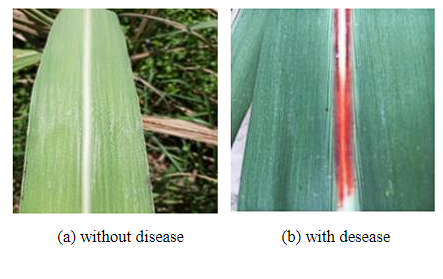Sugar Cane Red Stripe Disease Detection using YOLO CNN of Deep Learning Technique
doi: 10.14456/mijet.2022.25
Keywords:
YOLO, image processing, deep learning, Convolutional Neural Network, CNN, sugar cane, leaf-disease, image classificationAbstract
The objective of this research is to apply the deep learning technology based on the Convolutional Neural Network (CNN) algorithm YOLO, creating a simulation for image recognition. The technology was used to recognise the sugar cane disease with specified images. The Sugar cane-Leaf Disease Diagnosis System was designed and developed to enable the user to recognise sugar cane disease automatically. Sugar cane-Leaf Disease Diagnosis System consisted of two parts: the first part was the disease detection and diagnosis. This was where the Convolutional Neural Network learning-teaching import 4,000 images divided into 2,000 images of sugar cane leaves with disease and 2,000 images of sugar cane without disease for the comparison. The other part was the system for displaying response or disease diagnosis system interface. This part contained the Convolutional Neural Network used to categorize and analyzing the leaf condition that would be diseased and non-diseased. The tool used for sugar cane leaf recognition and analysis in this research was the Deep Learning technique based on a Convolutional Neural Network consisting of image classification, image analysis, and image processing. This tool was used to test 3 sample groups, which were selected from 9 promotional staff from Mitrphol sugar factory, Thailand, 3 operative agricultural academic experts from Khon Kaen Field Crop Research Center, Thailand, 2 system developers, and 30 local agriculturists. The average accuracy score of processing of the first and the second group was 95.90 % and 91.30% with the highest accuracy of 98.45% and 97.26%, respectively, while the average estimated time duration was 1.46 and 1.53 seconds, respectively.
References
Y. Liu, H. Pu and Da-WenSun, "Efficient extraction of deep image features using convolutional neural network (CNN) for applications in detecting and analysing complex food matrices," Trends in Food Science & Technology, vol. 113, pp.193-204, 2021.
Y. Yin, H. Li and W. Fu, "Faster-YOLO: An accurate and faster object detection method," Digital Signal Processing, vol.102, July, 102756, pp.1-11, 2020.
T. Kattenborn, J. Leitloff, F. Schiefer and S. Hinz, "Review on Convolutional Neural Networks (CNN) in vegetation remote sensing," ISPRS Journal of Photogrammetry and Remote Sensing, vol. 173, March, pp. 24-49, 2021.
J. Redmon and A. Farhadi, "YOLOv3: An Incremental Improvement," IEEE Conference on Computer Vision and Pattern Recognition (CVPR), Las Vegas, NV, USA, 2016.
X. Han, J. Chang and K. Wang, "You Only Look Once: Unified, Real-Time Object Detection," Procedia Computer Science, vol. 183, pp. 61-72 ,2021
B. Aakash and A. Srilakshmi, "MAGE: An Efficient Deployment of Python Flask Web Application to App Engine Flexible Using Google Cloud Platform," Inventive Communication and Computational Technologies, pp. 59-68
Ihsan Ali, Aftab Khan, Muhammad Waleed “A Google Colab Based Online Platform for Rapid Estimation of Real Blur in Single-Image Blind Deblurring” , International Conference on Electronics, Computers and Artificial Intelligence (ECAI), 2020
Introduction to Keras. [Online]: https://colab.research.google.com/drive/1R44RA5BRDEaNxQIJhTJzH_ekmV3Vb1yI#scrollTo=ggBJHZ3Z6E11 [Accessed Jan. 18, 2021].
Tutorials point, Google Colab Introduction, [Online]: https://colab.research.google.com/notebooks/intro.ipynb?utm_source=scs-index [Accessed Jan. 18, 2021].
M. Swain and S. Dhariwal, "A Python (Open CV) Based Automatic Tool for Parasitemia Calculation in Peripheral Blood Smear," International Conference on Intelligent Circuits and Systems (ICICS), pp.445-448, 2018.
C. Xianbao, J. Q. Guihua and Y. Z. Zhaomin, "An improved small object detection method based on Yolo V3," Pattern Analysis and Applications., 3 May, 2021.
S. Ray, K. Alshouiliy and D. P. Agrawal, "Vehicle Detection Using Different Deep Learning Algorithms from Image Sequence," Baltic J. Modern Computing, vol. 8, no. 2, pp. 347-358, 2020.
P. Bunruang and S. Keawplang, "Evauation of Sugarcan Plant Height Using UAV Remote Sensing," Engineering Access, vol.7, no.2, pp. 102, 2021.
P. Suphan, S. Kaewplang and W. Sa-Ngiamvibool, "Monitoring of Rice Growth with UAV-Derived Aerial Imagery, " Mahasarakham International Journal of Engineering Technology, vol.5, no.1, pp. 28-32, 2019.

Downloads
Published
How to Cite
Issue
Section
License

This work is licensed under a Creative Commons Attribution-NonCommercial-NoDerivatives 4.0 International License.








